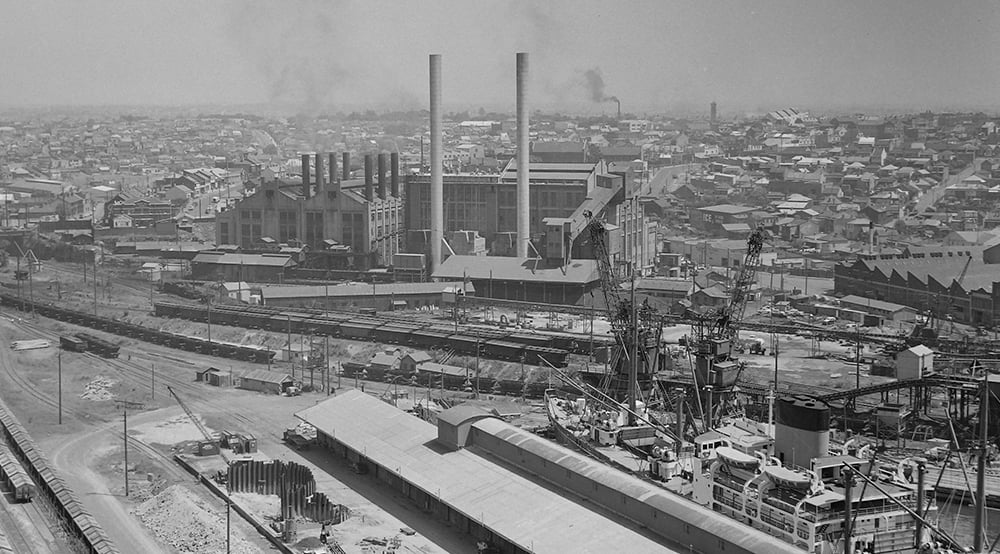The National Trust (NSW) has long called for the protection of White Bay Power Station in Rozelle. As the station opens its doors for the first time in decades, we celebrate the restoration of this monumental heritage space.
The soaring brick smoke stacks and steel-framed windows of White Bay Power Station are a well-known sight to anyone who drives across Sydney’s Anzac Bridge.
The National Trust (NSW) and local communities have long advocated for the heritage conservation and adaptive re-use of this monumental site, and over the past few years the site has been subject to a significant restoration program to sensitively revive the space for cultural and community use.
White Bay Station’s first program since its restoration is the 2024 Biennale of Sydney, which will be on display from March until June this year. It sets the scene for this heritage icon to be both celebrated for its past and reimagined for the future.

The past lives of White Bay Power Station
White Bay Power Station came into being when further electricity was needed for Sydney’s expanding tram networks and electrification of the railways in the early 20th century.
By 1910, a new power source had been recommended to satisfy accelerating demand, and the site of White Bay was selected for its convenient location and proximity to the water. Construction commenced in 1912, and the first stage of development for a coal-fired power station was complete and functional by 1917.
What would follow was almost 70 years of electrical output, making it the inner city’s longest serving power station. The site was expanded to a second stage in the 1920s, and again in the 1940s, with a post-war effort to replace the declining machinery onsite.
The buildings, with soaring interiors and large, steel framed windows, are a sight well-known to all who drive across the Anzac Bridge or frequent the suburbs between Glebe and Balmain.
With changing technological needs, the power station was decommissioned in 1984. Since then, it has, for the most part (other than a few movie shoots), remained out of use for the last forty years.
Its long abandonment sparked discussion about the future of the site, and as the exterior declined it was increasingly referred to as an eyesore. Various proposals were made for its repurpose throughout the following decades: for housing, a tourist destination, a naval base, a marine refuelling centre, a cement terminal, a facility to harvest stormwater, a Google headquarters, and even a renewable power station.

Advocating for protection
During these decades, the National Trust continuously fought for the site, both in its architectural form and its industrial heritage, to be appropriately conserved.
Within a year of the power station closing, the National Trust had formed a working group advocating for the items inside the power station to be assessed, recorded and cared for as a collection. There were calls for the Museum of Arts and Applied Sciences (now known as the Powerhouse Museum) to expand their museum into the premises, or an altogether new museum be established onsite.
The White Bay Power Station was listed by the National Trust (NSW) in 1994, a decade after operations onsite had ceased.
The same year, a discussion paper was brought forward, considering the future use of the place. Here, the National Trust once again called for the repair and care of the entire complex and its contents, noting “White Bay Power Station remains as the last opportunity for the conservation of power station buildings with associated equipment in the Sydney metropolitan area”.
1994 also saw the National Trust make a formal application to the Heritage Council for a conservation order, after fears that work at the site would damage the state of the building and lead to the removal of equipment, noting that “options for the reuse of the site have not been fully investigated”. The National Trust would also nominate the site to the National Estate.
White Bay Power Station would eventually be State heritage listed in 1999 and transferred to the NSW Government in 2000, ensuring the site would remain (for the most part) intact.
This listing allowed for the formal recognition of the importance of the site in the economic and technical development of electrical industry in Sydney, its connections to the working class origins of the Inner West, and the rare aesthetic features of the landmark complex.

Bringing the station back to life
While the power station has been subject to various remedial works over the past four decades, since 2021 there has been an extraordinary conservation effort to bring the site back to life.
In 2022 it was rezoned for community use, with a forecast to provide a public space predominantly for cultural and community use. As the surrounding Bays West area is developed with a new Metro station, a mixture of commercial and housing infrastructure and new parkland, White Bay Power Station will become an important element of a new metropolitan community.
The National Trust welcomes the restoration of this formidable complex, and we look forward to seeing its future unfold. Right now, you can see its temporary opening as a cultural space as part of the Sydney Biennale 2024.
Find out more
The National Trust has been campaigning to protect NSW’s built, cultural and natural heritage for over 75 years. Find out more about our advocacy work.
Stay up-to-date on future advocacy news
Subscribe to our free monthly e-newsletter to hear about our latest advocacy efforts for protecting NSW heritage.

 Twitter
Twitter Facebook
Facebook Linkedin
Linkedin Email
Email